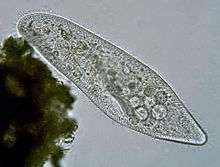Paramecium caudatum
| Paramecium caudatum | |
|---|---|
 | |
| Scientific classification | |
| Domain: | Eukaryota |
| (unranked): | Sar |
| Phylum: | Ciliophora |
| Class: | Oligohymenophorea |
| Order: | Peniculida |
| Family: | Parameciidae |
| Genus: | Paramecium |
| Species: | P. caudatum |
| Binomial name | |
| Paramecium caudatum | |
Paramecium caudatum[1] is a species of unicellular organisms belonging to the genus Paramecium of the phylum Ciliophora.[2] They can reach 0.25mm in length and are covered with minute hair-like organelles called cilia.[3] The cilia are used in locomotion and feeding.[2]
Appearance and physical characteristics
.jpg)
Paramecium caudatum is 120–330 micrometres long (usually 200–300 micrometres). The cell body is roughly cigar-shaped, rounded at the front, tapering at the posterior to a blunt point. The pellicle is uniformly covered with cilia, and has a long oral groove, leading to deeply embedded oral cavity, lined with cilia. P. caudatum has two star-shaped contractile vacuoles, and a cellular envelope (cortex) densely studded with spindle-shaped extrusomes called trichocysts. The species is very common, and widespread in marine, brackish and freshwater environments.[4][5]
P. caudatum feed on bacteria and small eukaryotic cells, such as yeast and flagellate algae.[2] In hypotonic conditions (freshwater), the cell absorbs water by osmosis. It regulates osmotic pressure with the help of bladder-like contractile vacuoles, gathering internal water through its star-shaped radial canals and expelling the excess through the plasma membrane.[3] When moving through the water, they follow a spiral path while rotating on the long axis.[2]
Paramecium have two nuclei (a large macronucleus and a single compact micronucleus).[6] They cannot survive without the macronucleus and cannot reproduce without the micro-nucleus.[3] Like all ciliates, Paramecia reproduce asexually, by binary fission. During reproduction, the macronucleus splits by a type of amitosis, and the micronuclei undergo mitosis. The cell then divides transversally, and each new cell obtains a copy of the micronucleus and the macronucleus.[7]
Fission may occur as part of the normal vegetative cell cycle. Under certain conditions, it may be preceded by self-fertilization (autogamy),[8] or it may follow conjugation, a sexual phenomenon in which Paramecia of compatible mating types fuse temporarily and exchange genetic material. During conjugation, the micronuclei of each conjugant divide by meiosis and the haploid gametes pass from one cell to the other. The gametes of each organism then fuse to form diploid micronuclei. The old macronuclei are destroyed, and new ones are developed from the new micronuclei.[9]
Without the rejuvenating effects of autogamy or conjugation a Paramecium ages and dies.[3] Only opposite mating types, or genetically compatible organisms, can unite in conjugation.[3]
References
- ↑ "Paramecium caudatum". Integrated Taxonomic Information System.
- 1 2 3 4 101 Science.com: Paramecium Caudatum
- 1 2 3 4 5 Paramacium
- ↑ Carey, Philip G. Marine interstitial ciliates: an illustrated key. 1992. p. 128
- ↑ "Paramecium caudatum". Encyclopedia of Life. Retrieved 2013-02-14.
- ↑ "Paramecium". Microbus. Retrieved 17 April 2018.
- ↑ Lynn, Denis. The ciliated protozoa: characterization, classification, and guide to the literature. Springer, 2010. 279.
- ↑ Berger, James D. "Autogamy in Paramecium cell cycle stage-specific commitment to meiosis." Experimental cell research 166.2 (1986): 475–485.
- ↑ Prescott, D. M., et al. "DNA of ciliated protozoa." Chromosoma 34.4 (1971): 355–366.